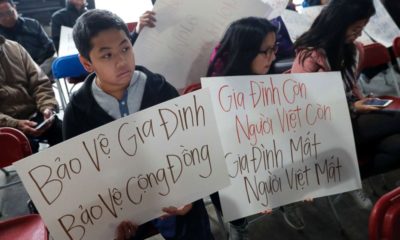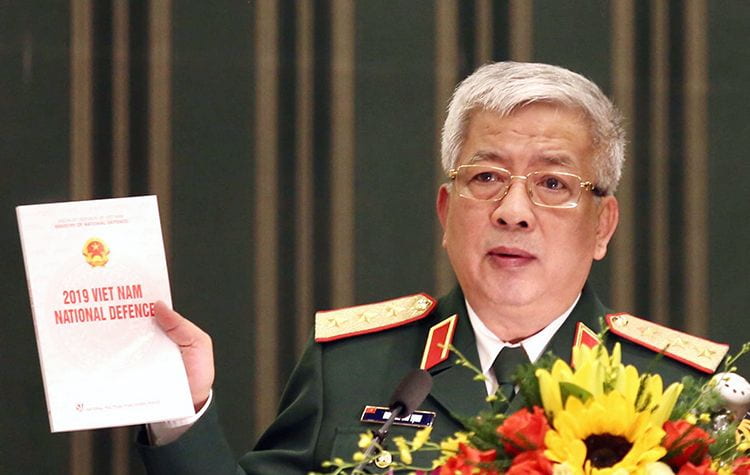By Tuong Vu
As 2019 is drawing to a close, Vietnam suddenly issued its long-awaited Defense White Paper (1). Given that the last White Paper was issued ten years ago, and the sharp rise of tension in the South China Sea in the last few years, this 2019 White Paper naturally received much attention from foreign governments and policy circles (2). While some pundits praised the document for drawing firm lines on Vietnam’s commitment to defend its sovereignty and independence (3), others have expressed surprise, and perhaps even disappointment, that the new White Paper does not contain much that is new (4).
This language has created confusion over whether “defense ties” and “cooperation” are really that different from “alliance” (5). Some also wonder if the rejection of the use of force is appropriate as Vietnam is much weaker militarily relative to China, its main contender in the South China Sea (6). If the purpose of the Vietnamese government is to bring greater clarity and transparency with the release of the White Paper, it is debatable whether Hanoi has succeeded.
In their analyses, observers have not asked why the new White Paper was released now. Because previous releases took place every five years since 1998 (in 1998, 2004, 2009), the long gestation of this document suggests the leadership’s deep feelings of uncertainty about defense policy and their inability to achieve consensus. This may explain the lack of clarity and the domination of old thinking in the document that has baffled analysts.
But the document has been issued despite those problems, and the question is why Vietnamese leaders bothered to publish such a defective product that conveyed nothing new. Observers have assumed that the new White Paper is meant for foreign countries. That is not wrong but the domestic audience may be equally as, if not more, important.
In the last three years, Vietnam has faced repeated setbacks in the South China Sea. In July 2017, Vietnam was forced to cancel an oil drilling project reportedly under the Chinese threat of military attack on one of its installations in the South China Sea. In March 2018, another project had to be canceled under similar circumstances, causing Vietnam to lose hundreds of millions (7).
Earlier this year, China sent the Haiyang Dizhi 8 survey vessel escorted by Coast Guard ships into the area around Vanguard Bank, which lies within Vietnam’s 200-nautical mile exclusive economic zone (8). Vietnamese authorities sent Coast Guard ships to trail Chinese ships for months but the state-owned press was not permitted to report what was happening. Once the news from foreign sources broke, facing questions from the public and popular demands for action, Hanoi raised diplomatic protests against Chinese actions, which were immediately rebuked by Beijing.
By the end of the summer, domestic pressure from veterans, intellectuals, retired officials, and the public was so intense that the Vietnamese government either allowed or did not prevent an unprecedented symposium to take place in Hanoi on October 6th. The symposium also was perhaps a signal Hanoi wanted to send to Beijing that the situation was near the breaking point. The symposium gathered various influential figures known as having ideas different from official policy, which include the “three no’s” above.
At the meeting, captured in a video later released on YouTube, retired Maj. Gen. Le Ma Luong, a decorated hero in the anti-American war, gave a provocative impromptu speech in which he criticized the government for having been reluctant to take China to the International Court on the basis of the United Nations Convention on the Law of the Sea (UNCLOS). Apparently speaking for many fellow veterans, he threatened to take them with him to the Ministry of Foreign Affairs “for a visit” if the Vanguard Bank were lost to China (9).
Even more incendiary were the former general’s brazen criticisms directed at the incumbent top brass of Vietnam’s People’s Army (VPA). He charged that they lacked war experience and were only interested in money. Calling out the names of the two highest-ranking generals, Gen. Ngo Xuan Lich, the Minister of Defense, and Gen. Luong Cuong, the Director of Political Department of the VPA, Gen. Le Ma Luong lamented that, for the first time in the history of the VPA, a Minister of Defense does not know how to read a military map (Gen. Ngo Xuan Lich is a career political officer, not military commander).
Following his speech, General Le Ma Luong was reportedly summoned by the Public Security Ministry for questioning (10). His criticisms stung Mr. Nguyen Phu Trong, the General Secretary of the Vietnamese Communist Party and Vietnam’s State President, who complained later that he and other Party leaders were no less “patriotic” (than the General), and pledged that Vietnam would do everything to preserve its territorial sovereignty (11).
Placed in the context of the events in the last three years and especially the Oct 6th Symposium, the timing of Vietnam’s new Defense White Paper did not appear coincidental. While drafts of the new White Paper must have been prepared long ago but kept in limbo for lack of consensus, strong pressures from both without and within must have pushed for its release despite all the defects.
The context also helps identify the other key audience of this document. The overall tone of the new White Paper, which is optimistic and reassuring about Vietnam’s position in the world, is clearly intended for a domestic rather than international audience. Vietnam’s dispute with China in the South China Sea is downplayed throughout the document. China in itself does not appear as a threat; rather, the threat comes from the rivalry among unnamed “big powers,” which may include the US, India, and Japan besides China.
In fact, the threat from “hostile forces in cahoots with domestic reactionary and opportunistic elements” looms larger in the document than any dispute Vietnam has with China (12). Observers of Vietnamese politics perhaps already know how such “hostile forces” play an outsize role in Vietnamese leaders’ threat perceptions. If so, they should not be surprised if the new Defense White Paper may be more about those dark forces than about China.
Still, it is unclear if the outspoken Gen. Le Ma Luong and his fellow veterans are persuaded. China will almost certainly send another vessel to survey Vietnamese waters next summer, and we will know it by then, if not earlier.
(This article is the first in a series of three installments about the new Defense White Paper. In the next installment, we will analyze the document more closely to understand Vietnamese leaders’ assessment of the world situation and their perceptions of threat).
Notes
[1] Bo Quoc Phong [Ministry of Defense], Quoc Phong Viet Nam 2019 (Hanoi: Chinh Tri Quoc Gia, 2019).
[2] Prashanth Parameswaran, Vietnam’s New Defense White Paper in the Spotlight
[3] Huong Le Thu, “Vietnam Draws Lines in the Sea,” Foreign Policy, December 6, 2019.
[4] “New White Paper Reveals Little Change to Vietnam’s Defence Policy” by Le Hong Hiep
[5] Sách trắng Quốc phòng 2019 của VN ‘cảnh báo Trung Quốc’
[6] Chính sách quốc phòng VN chuyển từ ‘3 không’ thành ‘4 không’
[7] South China Sea: Vietnam ‘scraps new oil project’
[8] Chinese survey ship leaves Vanguard Bank in South China Sea and heads to artificial island outpost
[9] Tướng Lê Mã Lương: Tôi sẽ cầm đầu quân nhân “hỏi tội” Bộ Ngoại Giao nếu để mất Bãi Tư Chính
[10] Bắc Kinh xâm lấn Tư Chính: Tướng Lê Mã Lương lên án việc chậm khởi kiện
[11] Không bao giờ nhân nhượng
[12] Bo Quoc Phong, Quoc Phong Vietnam 2019, p. 20.

 Politics & Economy4 years ago
Politics & Economy4 years ago
 Politics & Economy2 years ago
Politics & Economy2 years ago
 After 19751 year ago
After 19751 year ago
 ARCHIVES5 years ago
ARCHIVES5 years ago
 Society & Culture5 years ago
Society & Culture5 years ago
 Politics & Economy4 years ago
Politics & Economy4 years ago
 Politics & Economy5 years ago
Politics & Economy5 years ago
 Vietnamese-America4 years ago
Vietnamese-America4 years ago







